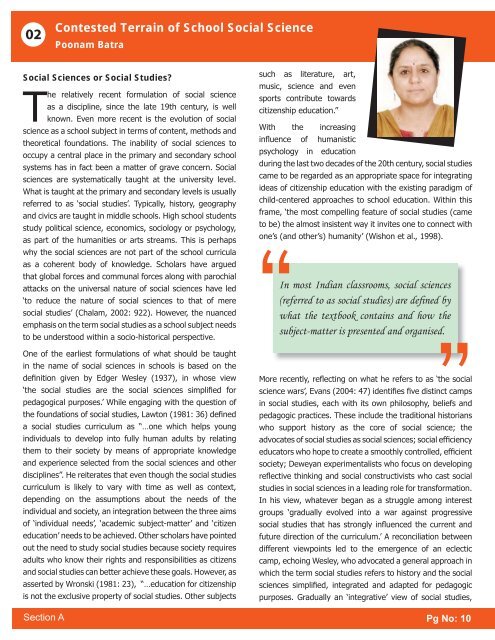Indesign Pagesnew.indd - Azim Premji Foundation
Indesign Pagesnew.indd - Azim Premji Foundation
Indesign Pagesnew.indd - Azim Premji Foundation
You also want an ePaper? Increase the reach of your titles
YUMPU automatically turns print PDFs into web optimized ePapers that Google loves.
02<br />
Section A<br />
Contested Terrain of School Social Science<br />
Poonam Batra<br />
Social Sciences or Social Studies?<br />
The relatively recent formulation of social science<br />
as a discipline, since the late 19th century, is well<br />
known. Even more recent is the evolution of social<br />
science as a school subject in terms of content, methods and<br />
theoretical foundations. The inability of social sciences to<br />
occupy a central place in the primary and secondary school<br />
systems has in fact been a matter of grave concern. Social<br />
sciences are systematically taught at the university level.<br />
What is taught at the primary and secondary levels is usually<br />
referred to as ‘social studies’. Typically, history, geography<br />
and civics are taught in middle schools. High school students<br />
study political science, economics, sociology or psychology,<br />
as part of the humanities or arts streams. This is perhaps<br />
why the social sciences are not part of the school curricula<br />
as a coherent body of knowledge. Scholars have argued<br />
that global forces and communal forces along with parochial<br />
attacks on the universal nature of social sciences have led<br />
‘to reduce the nature of social sciences to that of mere<br />
social studies’ (Chalam, 2002: 922). However, the nuanced<br />
emphasis on the term social studies as a school subject needs<br />
to be understood within a socio-historical perspective.<br />
One of the earliest formulations of what should be taught<br />
in the name of social sciences in schools is based on the<br />
defi nition given by Edger Wesley (1937), in whose view<br />
‘the social studies are the social sciences simplifi ed for<br />
pedagogical purposes.’ While engaging with the question of<br />
the foundations of social studies, Lawton (1981: 36) defi ned<br />
a social studies curriculum as “…one which helps young<br />
individuals to develop into fully human adults by relating<br />
them to their society by means of appropriate knowledge<br />
and experience selected from the social sciences and other<br />
disciplines”. He reiterates that even though the social studies<br />
curriculum is likely to vary with time as well as context,<br />
depending on the assumptions about the needs of the<br />
individual and society, an integration between the three aims<br />
of ‘individual needs’, ‘academic subject-matter’ and ‘citizen<br />
education’ needs to be achieved. Other scholars have pointed<br />
out the need to study social studies because society requires<br />
adults who know their rights and responsibilities as citizens<br />
and social studies can better achieve these goals. However, as<br />
asserted by Wronski (1981: 23), “…education for citizenship<br />
is not the exclusive property of social studies. Other subjects<br />
such as literature, art,<br />
music, science and even<br />
sports contribute towards<br />
citizenship education.”<br />
With the increasing<br />
infl uence of humanistic<br />
psychology in education<br />
during the last two decades of the 20th century, social studies<br />
came to be regarded as an appropriate space for integrating<br />
ideas of citizenship education with the existing paradigm of<br />
child-centered approaches to school education. Within this<br />
frame, ‘the most compelling feature of social studies (came<br />
to be) the almost insistent way it invites one to connect with<br />
one’s (and other’s) humanity’ (Wishon et al., 1998).<br />
In most Indian classrooms, social sciences<br />
(referred to as social studies) are defi ned by<br />
what the textbook contains and how the<br />
subject-matter is presented and organised.<br />
More recently, refl ecting on what he refers to as ‘the social<br />
science wars’, Evans (2004: 47) identifi es fi ve distinct camps<br />
in social studies, each with its own philosophy, beliefs and<br />
pedagogic practices. These include the traditional historians<br />
who support history as the core of social science; the<br />
advocates of social studies as social sciences; social effi ciency<br />
educators who hope to create a smoothly controlled, effi cient<br />
society; Deweyan experimentalists who focus on developing<br />
refl ective thinking and social constructivists who cast social<br />
studies in social sciences in a leading role for transformation.<br />
In his view, whatever began as a struggle among interest<br />
groups ‘gradually evolved into a war against progressive<br />
social studies that has strongly infl uenced the current and<br />
future direction of the curriculum.’ A reconciliation between<br />
different viewpoints led to the emergence of an eclectic<br />
camp, echoing Wesley, who advocated a general approach in<br />
which the term social studies refers to history and the social<br />
sciences simplifi ed, integrated and adapted for pedagogic<br />
purposes. Gradually an ‘integrative’ view of social studies,<br />
Pg No: 10

















